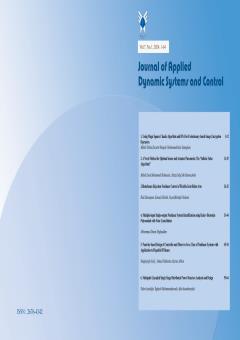Simulation and analysis of the residual volume of the drop hitting a cylinder with a rhombus cross section by volume of Fluid method
Subject Areas : Mechanical EngineeringJavad Alishah 1 , Soroush Madah 2 , جواد علی نژاد 3 , yassr rostamiyan 4
1 - , Ph.D. student, Department of Mechanical Engineering, Sari Branch, Islamic Azad University, Sari, Iran
2 - Department of Mechanical Engineering, Sari Branch, Islamic Azad University, Sari, Iran
3 - Department of Mechanical Engineering, Sari Branch, Islamic Azad University, Sari, Iran
4 - Department of Mechanical Engineering, Sari Branch, Islamic Azad University, Sari, Iran
Keywords: cylinder, rhombic cross-section, residual drop volume, volume of Fluid method,
Abstract :
Abstract In this article, the impact of a water drop on a horizontal cylinder with a rhombus cross-section is simulated in three dimensions. The innovation of the present work is to investigate the change in the shape of the division and the remaining volume of the collision of a Newtonian droplet with a rhombic cross-section. For the numerical simulation of this phenomenon, the volume of Fluid method based on the dynamic contact angle has been used to track the fluid-solid interface. To validate the results, the impact of a water drop with a diameter of 2 mm at a speed of 1 m/s on a horizontal pipe with a diameter of 3.18 mm and a deviation of 1.55 from the center has been simulated. The simulated images of drop shape change after impact agree well with the experimental results. Then the impact of drops on cylinders with a rhombus section was investigated. The calculation of the remaining and divided volume of the drop shows that the maximum remaining volume of the drop (2.7522 x 10-9m3) is on the cylinder with a diameter of d= 2.4 mm and speed V= 1m/s and the minimum remaining volume of the drop (0.8391 x 10-9m3) on the cylinder with a diameter of d= 1.6 mm and speed V=2 m/s.
[1] J. Q. Feng, "A deformable liquid drop falling through a quiescent gas at terminal velocity", J. Fluid Mech, 2010, 658, 438-462.
[2] L. Gottesdiener, D. Gueyffier, M. Abdelouahab, R.Gatignol, and S. Zaleski, "Mumerical simulations of large falling drops", Int. J . Mum. Methods Fluids, 2004, 45(1), 109-123.
[3] J. Han and G. Tryggvasson, "Secondary breskup of axisymmetric liquid drops. I. Acceleration by a constant body force" , Phys. Fluids, 1999, 11(12), 36-50.
[4] ShinanChang, HeSong, KeWu, “Experimental investigation on impact dynamics and freezing performance of water droplet on horizontal cold surface,” Sustainable Energy Technologies and Assessments, Vol. 45, 101128, 2021.
[5] Zhiyuan Ma, W.Xiong, P.Cheng, “3D Lattice Boltzmann simulations for water droplet's impact and transition from central-pointy icing pattern to central-concave icing pattern on super cooled surfaces. Part II: Rough surfaces,” International Journal of Heat and Mass Transfer, Vol. 172, 121153, 2021.
[6] KeZhao, YuWang, YangDing, YanlongJiang, “Numerical and theoretical study on the spreading characteristics of droplet impact on a horizontal flowing liquid film,” Colloids and Surfaces A: Physicochemical and Engineering Aspects, Vol. 616, 126338, 2021.
[7] JiaLuo, Shuang-YingWu, LanXiao, Zhi-LiChen, “Parametric influencing mechanism and control of contact time for droplets impacting on the solid surfaces,” International Journal of Mechanical Sciences, Vol. 197, 106333, 2021.
[8] HaixiangZhang, XiwenZhang, XianYi, FengHe, Fenglei Niu, PengfeiHao, “Effect of wettability on droplet impact: Spreading and splashing,” Experimental Thermal and Fluid Science, Vol. 124, 110369, 2021.
[9] TaoLi, LishuZhang, MingyuLid, MengYan, ErliNi, YingRuan, HuiLi, “Non-retraction rebound of the impacting nano-droplets,” Journal of Molecular Liquids, Vol. 329, 115521, 2021.
[10] JiajunWang, GangtaoLiang, TianjiaoWang, YiZheng, HaibingYu, ShengqiangShen, “Interfacial phenomena in impact of droplet array on liquid film,” Colloids and Surfaces A: Physicochemical and Engineering Aspects, Vol. 615, 126292, 2021.
[11] TianyuMa, DaweiChen, HaiquanSun, DongjunMa, AiguoXu, PeiWang, “Dynamic behavior of metal droplet impact on dry smooth wall: SPH simulation and splash criteria,” European Journal of Mechanics - B/Fluids, in press, 2021.
[12] VsevolodSklabinskyi, IvanPavlenko, “Intensification of mass transfer processes through the impact of the velocity gradient on hydrodynamics and stability of liquid droplets in a gas flow,” Chemical Engineering Science, 235, 116470, 2021.
[13] YanzhouQin, QiaoyuGuo, RouxianChen, YuanZhuang, YulinWang, “Numerical investigation of water droplet impact on PEM fuel cell flow channel surface,” Renewable Energy, Vol. 168, pp. 750-763, 2021.
[14] Yee LiFan, ZhibingZhan, ChunleiGuo, Jeong-HyunKim, JinkeeLee, “Retraction dynamics of a water droplet impacting onto a micro grooved hydrophobic surface at different velocities and surface temperatures,” International Journal of Heat and Mass Transfer, Vol. 168, 120851, 2021.
[15] ZhenyanXia, YangZhao, ZhenYang, ChengjuanYang, LinanLi, ShibinWang, MengWang, “The simulation of droplet impact on the super-hydrophobic surface with micro-pillar arrays fabricated by laser irradiation and salinization processes,” Colloids and Surfaces A: Physicochemical and Engineering Aspects, Vol. 612, 125966, 2021.
[16] G.Y.Li, X.J.Ma, B.W.Zhang, H.W.Xu, “An integrated smoothed particle hydrodynamics method for numerical simulation of the droplet impacting with heat transfer,” Engineering Analysis with Boundary Elements, Vol. 124, p.p. 1-13, 2021.
[17] KeisukeUeda, Lynne S.Taylor, “Partitioning of surfactant into drug-rich nanodroplets and its impact on drug thermodynamic activity and droplet size,” Journal of Controlled Release, Vol. 330, p.p. 229-243, 2021.
[18] C. W. Hirt and B. D. Nichols, Volume of fluid (VOF) method for the dynamics of free boundaries", J. Comput. Phys., 1981039, 201.
[19] Pasandideh-Fard M, Bussmann M, Chandra S, Mostaghimi, J (2001) Simulating Droplet Impact On a Substrate of Arbitrary Shape. Atomization Sprays 11(4):397–414.


